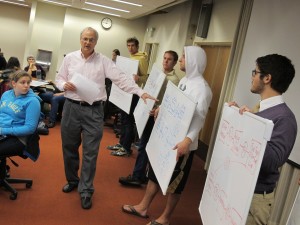Year in Review: The 10 Biggest Education Stories of 2011

Kyle Stokes / StateImpact Indiana
Troy Cockrum, an English teacher at St. Thomas Aquinas Catholic school photographed in October, helps a student having computer issues. Cockrum “flipped” his classroom this year, and painted the walls of his classroom with tech-savvy terminology to reflect the new change.
As we all get ready to pop the bubbly, celebrate a remarkable year, and count down to midnight, we at StateImpact thought we’d put together a countdown of our own — the top ten most popular posts of 2011.
Here’s to a great 2012, a Happy New Year to you and yours, and many thanks for making these ten stories StateImpact‘s most-viewed:
10. Why Schools Should Keep Teaching Handwriting, Even If Typing Is More Useful (September 29)
“Even if computers will dot students’ I’s and cross their T’s for much of their life, Indiana University research suggests teaching them handwriting skills is still important in helping them learn to read…” Read the post →
9. Why The ‘Automatic’ Cuts Spurring The Debt Supercommittee May Not Be So Automatic (November 1)
“For the Congressional supercommittee, failure is not an option, right? President Obama said it himself, didn’t he? If the supercommittee doesn’t agree on budget cuts to reduce the nation’s deficit, $1.2 trillion in budget cuts — including $3.5 billion to federal education programs — would kick in automatically. Or would they?…” Read the post →
8. Could Making Standardized Tests Less Secure Stop Teacher Cheating? (September 15)
“Here’s a thought: If teacher cheating scandals in Atlanta and elsewhere are the result of keeping standardized tests top secret, why not put test items ‘out in the sun instead of trying to lock them up in more and more secure rooms’?” Read the post →

Kyle Stokes / StateImpact Indiana
Professor Larry Nies leads a discussion in his environmental engineering course. This year, Nies redesigned the class's structure to make it more student-driven and discussion-based.
7. How Purdue Aims To Boost One Of The Big Ten’s Lowest Graduation Rates (November 28)
“Saddled with one of the lowest four-year graduation rates in the Big Ten, Purdue redesigned 10 first– and second-year courses — all formerly taught in a traditional lecture format — to be more interactive and student-driven. Administrators hope revamping these courses will stop freshmen from falling behind and help the university earn a bigger share of $61 million in performance funding from the state.” Read the post →
6. How Useful Are College Rankings? (September 9)
“The publication’s choice of research partners has sparked protest from many of the nation’s leading teacher colleges, with a number of schools refusing to respond to inquiries from the publication or its partner, the National Council on Teacher Quality. Many schools are accusing the group of using the college ranking guide as a pulpit to promote a political agenda.” Read the post →
5. For-Profit Colleges: Game-Changers Or Diploma Mills? (November 25)
“For-profit colleges have a lot of accusatory fingers pointing in their direction, mostly from politicians and commentators looking for someone to blame for soaring levels of student debt. But are for-profits indeed fatally flawed ‘diploma mills’? Or convenient scapegoats?” Read the post →
4. Why Snow Days Might Be Bad For Kids (November 29)
“As parts of Indiana brace for the first slushy snowfall of the season, consider a 2009 study that found passage rates on standardized math tests fell by as much as half of a percentage point for each inch of snow.” Read the post →
3. Easy A? The 10 Departments At IU & Purdue Giving The Most A’s (July 27)
“Looking to graduate college with lots of A’s on your transcript? Major in Aerospace Studies at Indiana University, or take a lot of band classes at Purdue. Amid the debate over grade inflation across the country — a national study found three out of every four students at public flagship universities earn either an A or a B in their classes — we took a closer look at grades data at Indiana’s flagship universities, IU and Purdue.” Read the post →
2. In College Dorms & Dining, How Nice Is Too Nice? (August 18)
“Nearly half of U.S. students factor in their on-campus dining options into their choice of where to go to college, which has turned college food services a $4.6 billion dollar industry. It’s also made some Indiana University trustees wonder whether it’s economically feasible for the school to take part in an ‘amenities race’ to build the nicest dining facilities and residence halls.” Read the post →
1. How YouTube Is Changing The Classroom (October 12)
“As long as there have been teachers, they’ve battled the same problems: How can they reach students of multiple ability levels at once, cover more course material in limited time, and find more time to engage with students one-on-one? Some educators think they’ve found a solution to all three problems in, of all things, YouTube.” Read the post →

